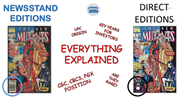
There is a lot of confusion in the market about the difference between newsstand and direct editions. Sellers on eBay regularly confuse the two. And it’s not just folks new to collecting. I’ve spoken with comic shop owners that don’t know the difference between newsstand and direct editions. Even major online comic retailers are currently listing comics incorrectly. Here are a few quick examples to make the point.


Understanding the difference is important because depending on the year, newsstand variants are MUCH rarer than their direct edition counter parts. As a result, they often command a much higher price. At other points in time, however, newsstands are MORE COMMON than direct editions and there’s no reason why they should be more expensive.
Knowing which newsstands are rare and which ones are common will keep you from getting taken advantage of and also help you find deals – and there are a lot of deals to be had if you know what to look for.
So, in this post I’ll explain:
- The history of newsstand and direct editions.
- How to identify newsstand and direct editions.
- Are newsstands actually rare?
- How grading companies treat newsstand editions.
- Why does any of this matter?
The (Simplified) History of Newsstand and Direct Editions
If we were to jump into a time machine and go back to the late 1970’s and early 1980’s we would find fewer comic shops. A lot fewer. Up until the mid-1980’s most comics were sold in general stores like pharmacies or bookstores or newsstands. The business model looked something like this:
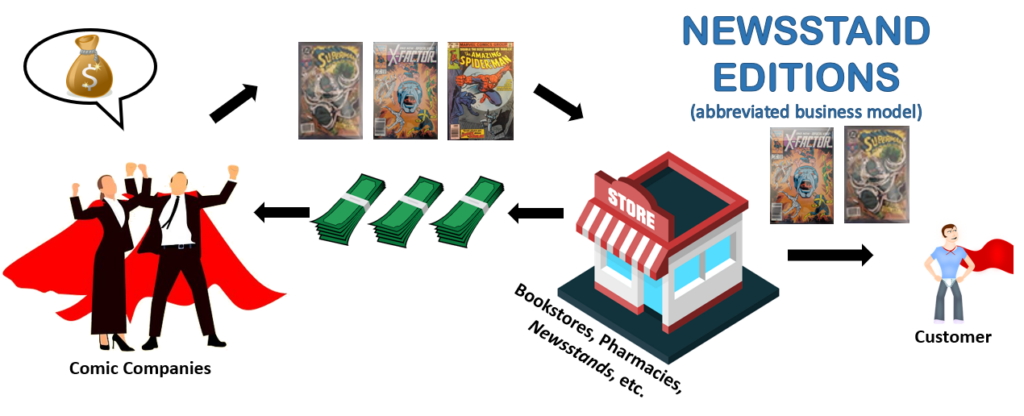
Comic companies would sell comics to general retailers. These retailers would then sell the comics to customers. The problem was that the comic companies didn’t really like this model. This is because if the stores didn’t sell their comics, they could return their unsold inventory back to the comic companies who were required to buy the issues.

This process of refunding unsold comics was tracked through the bar code on these newsstand editions. Stores were frequently required to tear off and submit the cover for reimbursement to ensure that they weren’t double dipping, that is selling comics and requesting a refund.
But as the industry matured more and more local comic shops began to spring up. These local comic shops began to represent a greater and greater share of comic book sales. Eventually the comic companies came up with a new business model. They would sell comics to local comic shops at a discount, but in exchange for the discount these shops would not be able to return inventory that they didn’t sell. This is the direct edition model.
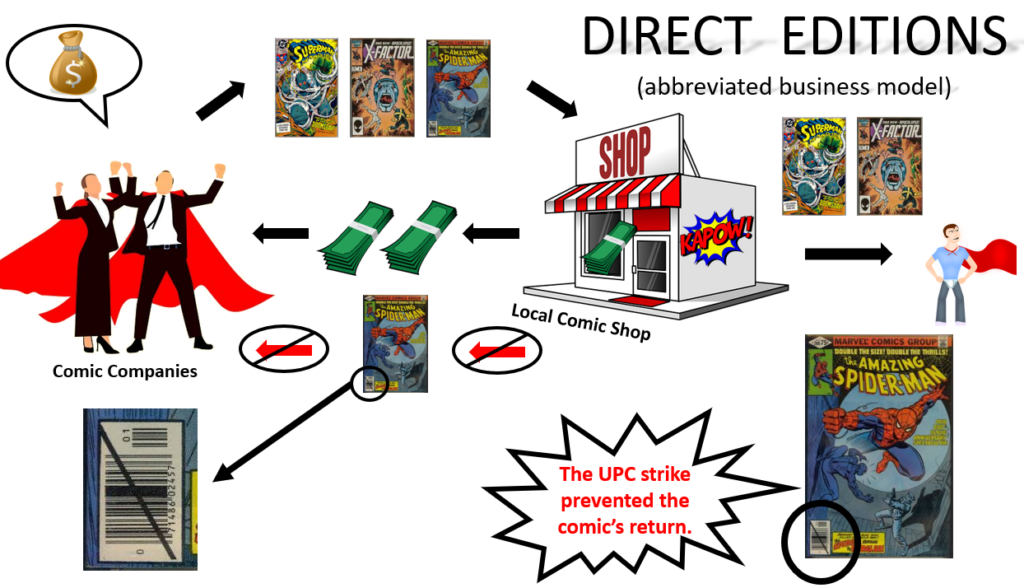
Comics sold under this business model had a strike running through the UPC that prevented the comic from being returned. This provided the comic companies with some stability in their revenue because they wouldn’t have to issue refunds and provided local comic shops with a discount in exchange for keeping everything they ordered.
But what happened when comic shops ordered more comics than they could sell? Dollar bins were born! (Or at least became a lot more common.)
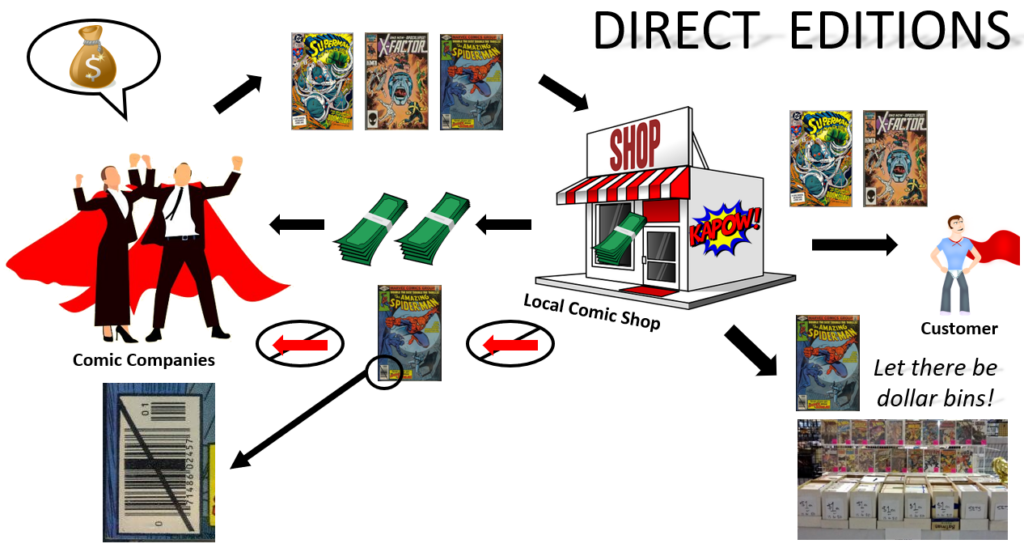
However, the UPC strike through didn’t last long. It’s ugly and visual appeal has always been a large part of comic collecting. But comic companies still needed some way to distinguish direct editions from newsstand editions and soon began filling the UPC box with art.
As you can see, however, that didn’t last long either.
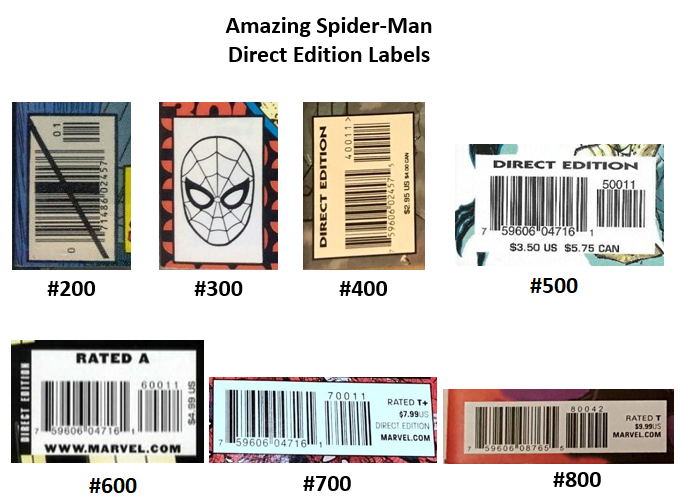
I don’t think there’s a single reason why bar codes came back, but I do have a couple best guesses. At their beginning direct editions needed to have an alternative to the bar codes on newsstands, but as newsstands became less and less common there was simply less of a need to distinguish them. Additionally, at the same time that newsstands were becoming less common, comic companies began printing multiple variant covers of the same issue. Bar codes made it easier to track these for both comic companies and collectors.
How To Identify Newsstand Editions
Despite the massive amounts of confusion surrounding this issue, it’s actually really easy to identify newsstand editions. They, of course, have a bar code, but as seen above, direct editions in the late 1990’s and afterwards also have bar codes. So how can you tell a newsstand edition?
Sometimes the UPC self-identifies as a newsstand edition. That’s always helpful, but it’s also uncommon. The surest way to identify a newsstand edition is to look at the second part of the bar code in the UPC box. Direct editions have five numbers and newsstand editions have two numbers.
Here are a few examples.
Batman #457 is the first appearance of Tim Drake as Robin.
CLICK TO SEE CURRENT EBAY PRICES.
Daredevil #21 is the first appearance of the Superior Spider-Man.
CLICK TO SEE CURRENT EBAY PRICES.
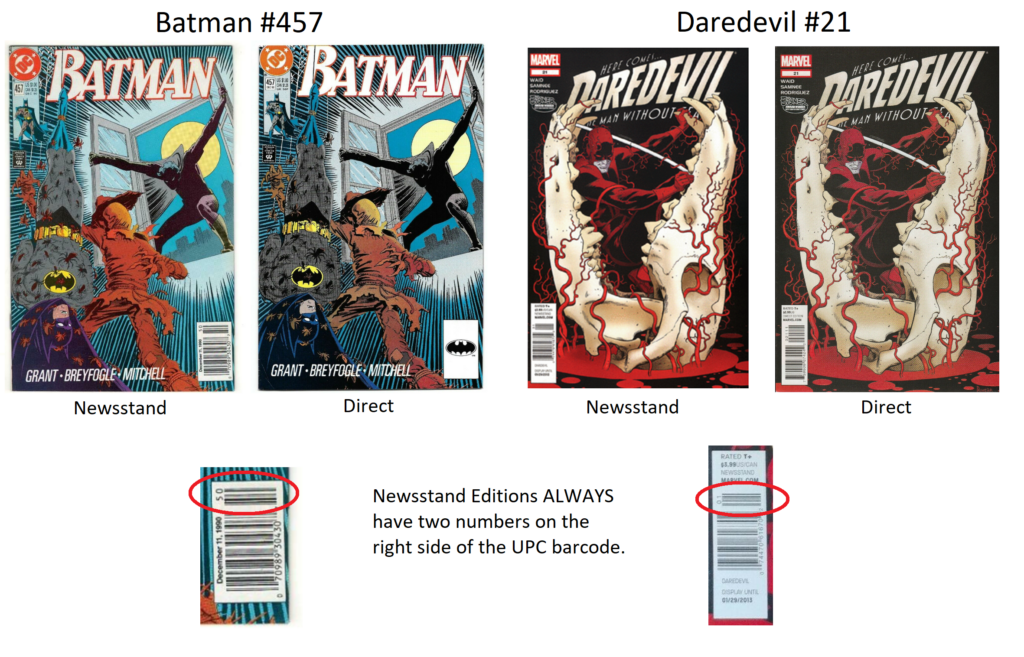
Are Newsstand Editions Actually Rare?
Whether newsstand editions are rare compared to direct editions depends on two factors: year of publication and condition of the comic. Newsstand editions are more common in older comics and much rarer in newer comics. This is because newsstands were printed in fewer quantities as time went on and the people that stocked and bought them were less likely to take care of them. This means that recent newsstand editions in near mint condition can be extremely rare.
Mile High Comics is one of the few comic companies that recognized early on how difficult is to find NM copies of later newsstands. When they began distinguishing newsstand editions from direct editions and charging more for the former they got some questions on the decision. In response they published a very helpful justification that included the following data and statement:
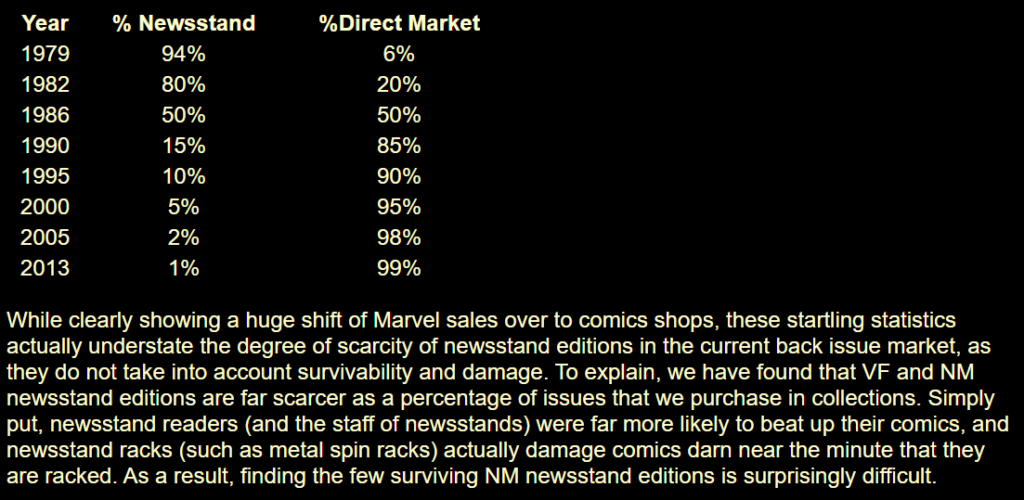
To better illustrate the scarcity of high grade newsstand editions I made the following graph. Here you can see that after 1986 direct editions are increasing as a percentage of print runs and distribution and newsstand editions decrease.
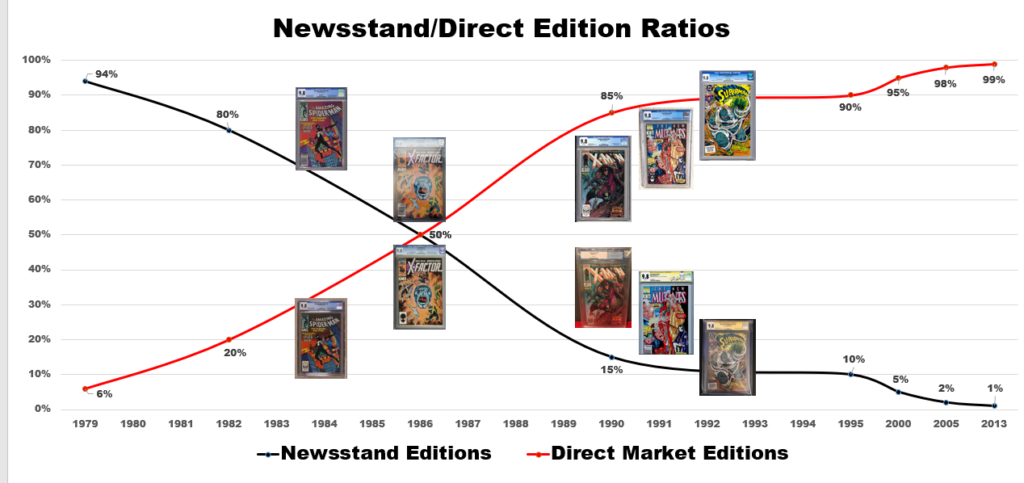
But when you look at this graph it’s important to remember the role that condition plays in the scarcity of a comic. The closer to the present the more unlikely it is to find a 9.8 newsstand. An easy experiment will bear this out…
Search eBay to see how many Amazing Spider-Man #252 CGC 9.8’s there are in newsstand and direct editions and then do the same with X-Factor #6 CGC 9.8, X-Men #266 CGC 9.8, and New Mutants #98 CGC 9.8. And in case you think that this is limited to Marvel look at Doomsday’s first appearance in Superman: Man of Steel #18. See how many more direct editions there are than newsstand editions? If this sounds like a lot of work you can also watch me do it here:
The bottom line is that newsstands are much rarer than direct editions in later years (after 1986) especially in higher grades (9.4+).
How Grading Companies Treat Newsstand Editions
One of the biggest misconceptions about newsstand editions is the widespread and persistent belief that grading companies don’t distinguish between direct and newsstand editions. This is simply flat out false. Every major grading company recognizes newsstand editions in some capacity.
Let’s look at CGC first since it is the premiere grading company (this is not an endorsement of CGC, it’s just a fact of the marketplace right now). CGC recognizes newsstand editions as variants if they meet a specific set of requirements. For example, it the content of the comic differs between direct and newsstand editions, or, sometimes if there are price differences.
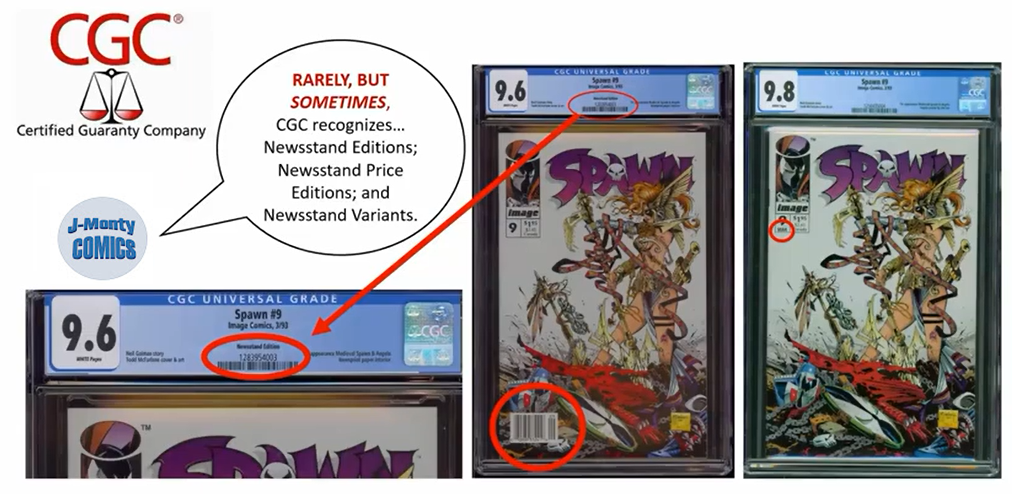
Spawn #9, the first appearance of Angela and Medieval Spawn, is a great example of when CGC will recognize newsstand editions. The direct edition of Spawn #9 is on nice glossy paper and contains a poster. The newsstand edition is printed on horrible low quality paper without a poster. The newsstand also has a bar code, but that alone will not get newsstands noted on the label.
A more recent example is Daredevil #21. CGC notes that it is a newsstand in part because it carries a different (higher) price.
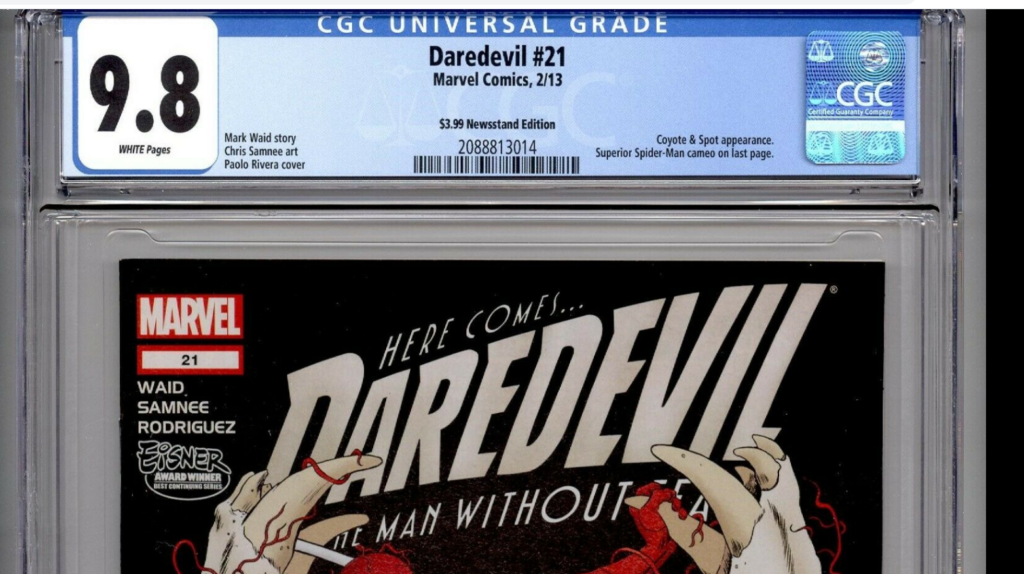
Next, let’s look at CBCS. This is an easy one because CBCS really is taking the lead in advancing the industry by flat out no exception recognizing newsstand editions. As a collector I really appreciate this – it’s just giving the community more and better information. They announced this as their policy on Facebook a few years ago.
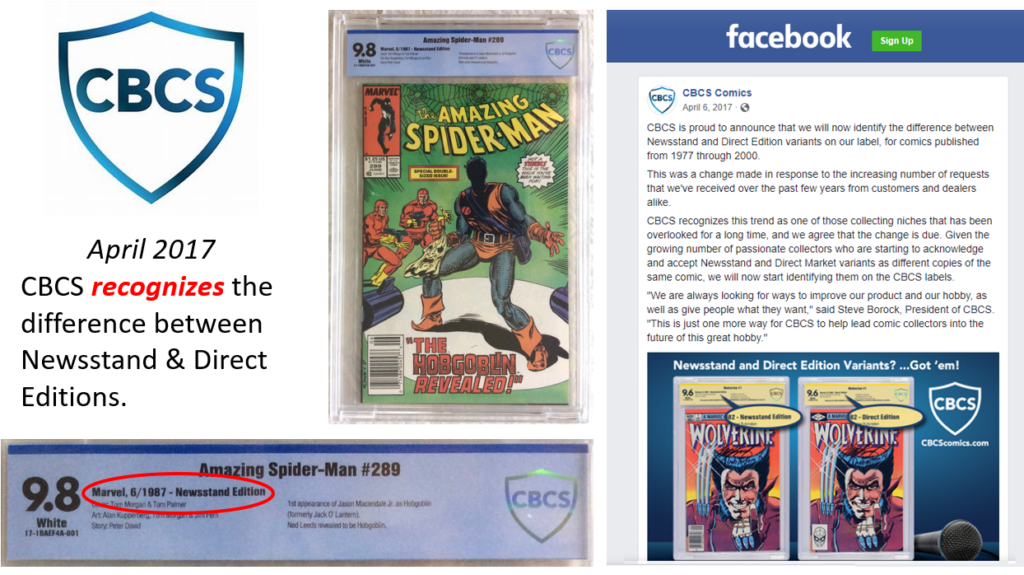
Finally, PGX has recognized newsstand editions for a long time.
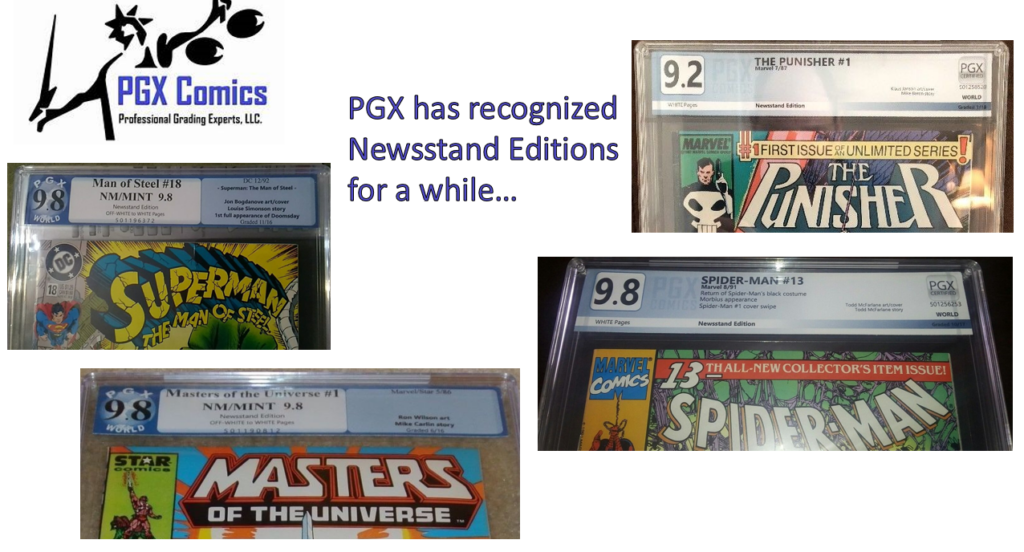
Who Cares? Does Any Of This Matter?
While doing research for this post I came across a lot of heated conversation about newsstand editions. It’s amazing how passionate some people are about disliking these particular variants. Here’s an unscientific sample I clipped for this post. Look at the hate?!
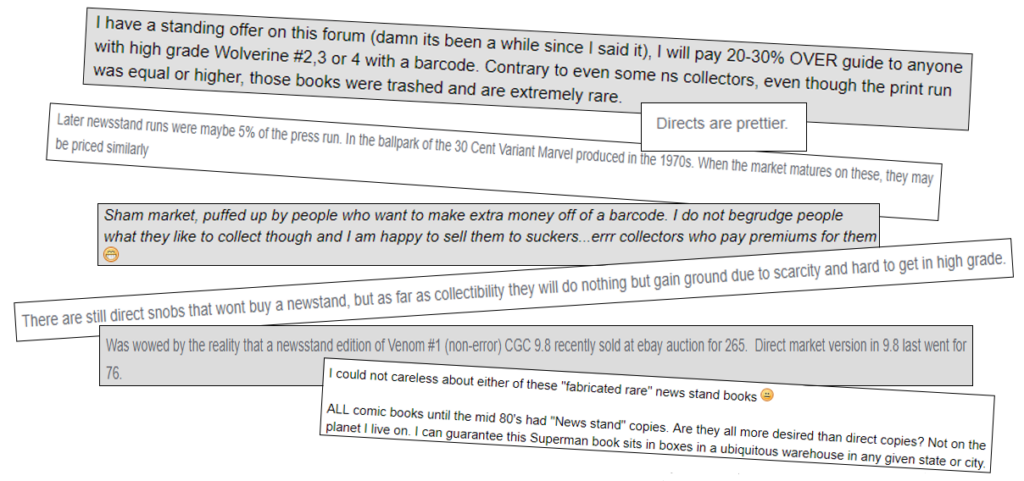
But even if you dislike newsstands, that’s not stopping other people from paying a LOT more for them. Especially in recent printings. Perhaps the best example of this is the first appearance of Miles Morales in Ultimate Fallout #4. A same day sale of both issues in CGC 9.8 condition resulted in a difference of more than $7,000.
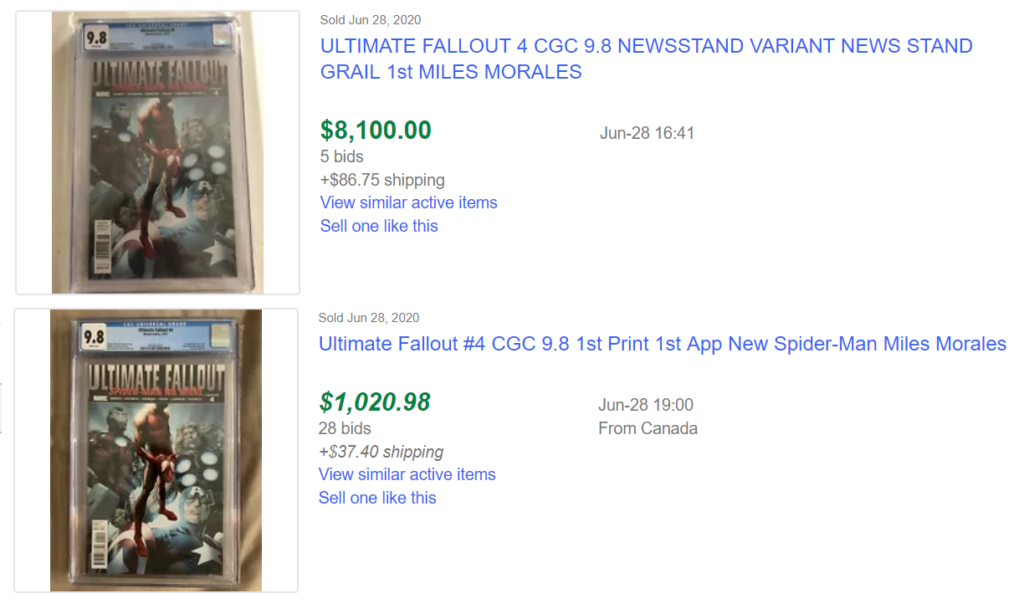
Love newsstand editions or hate them, if you have any financial interest in collecting, it’s probably best not to ignore them.

This new adult comic world was literally dropped on my porch last summer. About 60 long boxes threw me for a loop. I’ve been trying to learn the ins and outs, but emotions, greed, and timing change a lot of what should be just common sense. The Newsstands vs Direct are a perfect example. Since I’m more of a car guy than a comic guy, I had to reason it out in my head like this: the Newsstands of yore were the split window Corvette’s of their day…less attractive, harder to drive (at least in reverse..or find in collectors grade, as it may be). People were more than happy to see them have a short run and that was that. Oh! But wait. Collector’s got involved. They talked them up. They bought them up. And they sold them at huge margins over any other vets of their day. I liked the guy that said he didn’t like them but was glad to jack up the price and sell them…right up to the moment he called them sucker’s. Maybe he doesn’t realize that all of us collector’s could be called a lot of things by a lot of people who don’t understand what drives us. Whether its reading comic’s, collecting comics, or making a living from them. We should all just be grateful that we all co-exist at this wonderful covid laden time. I personally feel like I have a few million friend’s out there, rather than focussing on the few million people that dont seem to get what our current administration is doing to all of us. Comic’s have been a source of sanity amongst all of the insanity for me. So if you’re a hater, #@$@ off and die. I only have time to enjoy and people like you aren’t on my to do list.
Lot of truth in what you said. I hope people collect what they love – it’s what makes it fun and meaningful! Forget about the critics. I mean why would anyone care what someone else collects? Thanks for reading!
Very helpful. VERY INTUITIVE and easy read. Thank you. I’ve been collecting my whole life. I’m 37 years old, but had a six or seven year hiatus and am starting up again. A lot of things are still confusing but articles like this make it much easier. Thank God for people like you writing insightful and entertaining articles in which people like myself can fully understand the hobby and lifestyle better. I love what that guy said, if you’re a hater “F OFF”. Thank you! Great stuff.
Thanks for the note! And welcome back to the hobby!
Thank you for writing this article that is very interesting and clearly explained. It was very educational for me to learn about how the relative scarcity of newsstand editions changed over time. It is like taking a history lesson in comic collecting, which is a very interesting topic for me. God bless!
Thank you for the article…it is of worthy note that comics that were relegated to drugstores and newstands were often not as gingerly stocked on the types of displays a s comic shops. but most likely on spinning racks. handled, picked up, thumbed through, and put back assuring a greater element of wear and tear on a non-direct distribution model. Collectors who appreciated the comic books would take greater care at the direct shops….Examples of a “newsstand’ edition comics that are in great condition would therefore be somewhat rarer due to wear and tear in my opinion. An additional category that is worth exploring would be books that were purchased via subscription….those in great condition may be rarer yet.
This was an outstanding article. I’m a pretty avid collector, and I feel a bit better knowing that I’m not the only one who didn’t know the distinction between the two.
Just bookmarked your site, looking forward to checkout if more if your stuff!
Thanks, Nick! I’m glad you liked the article!